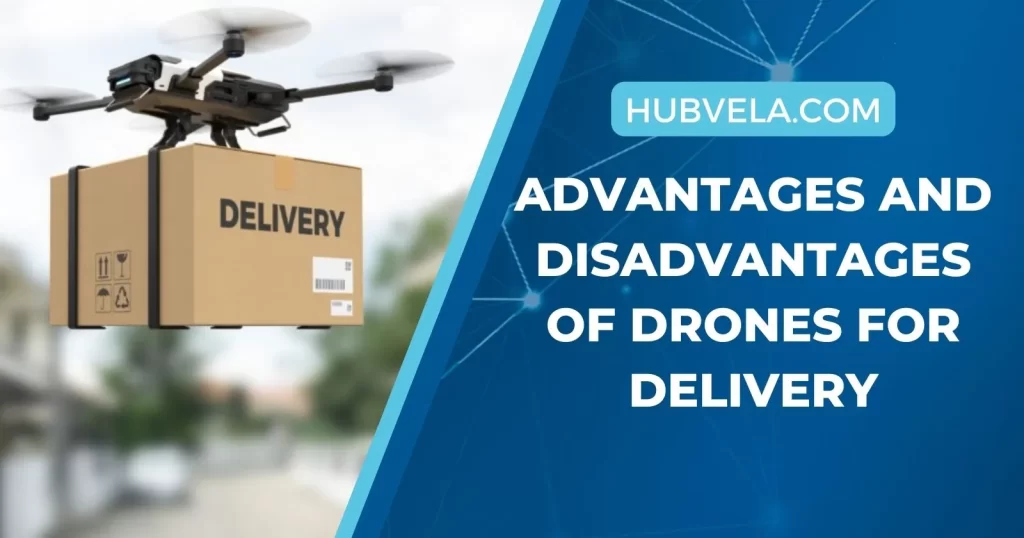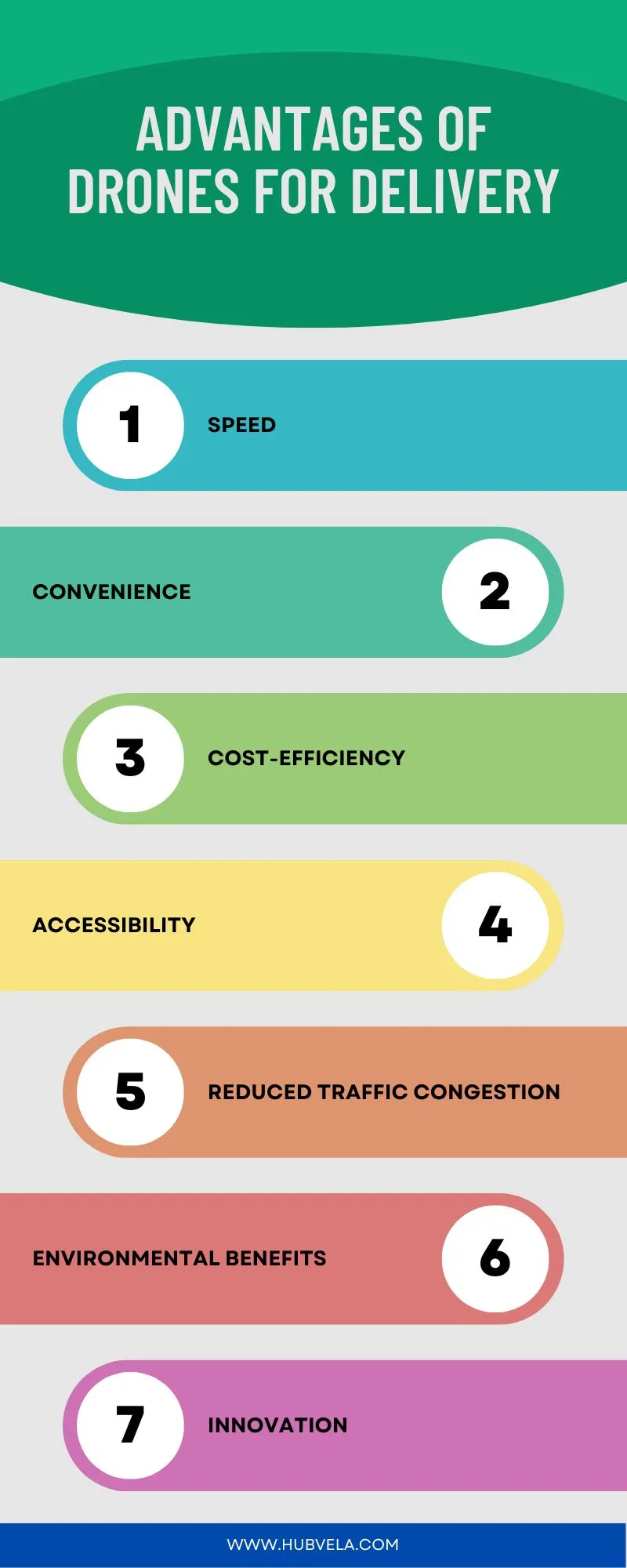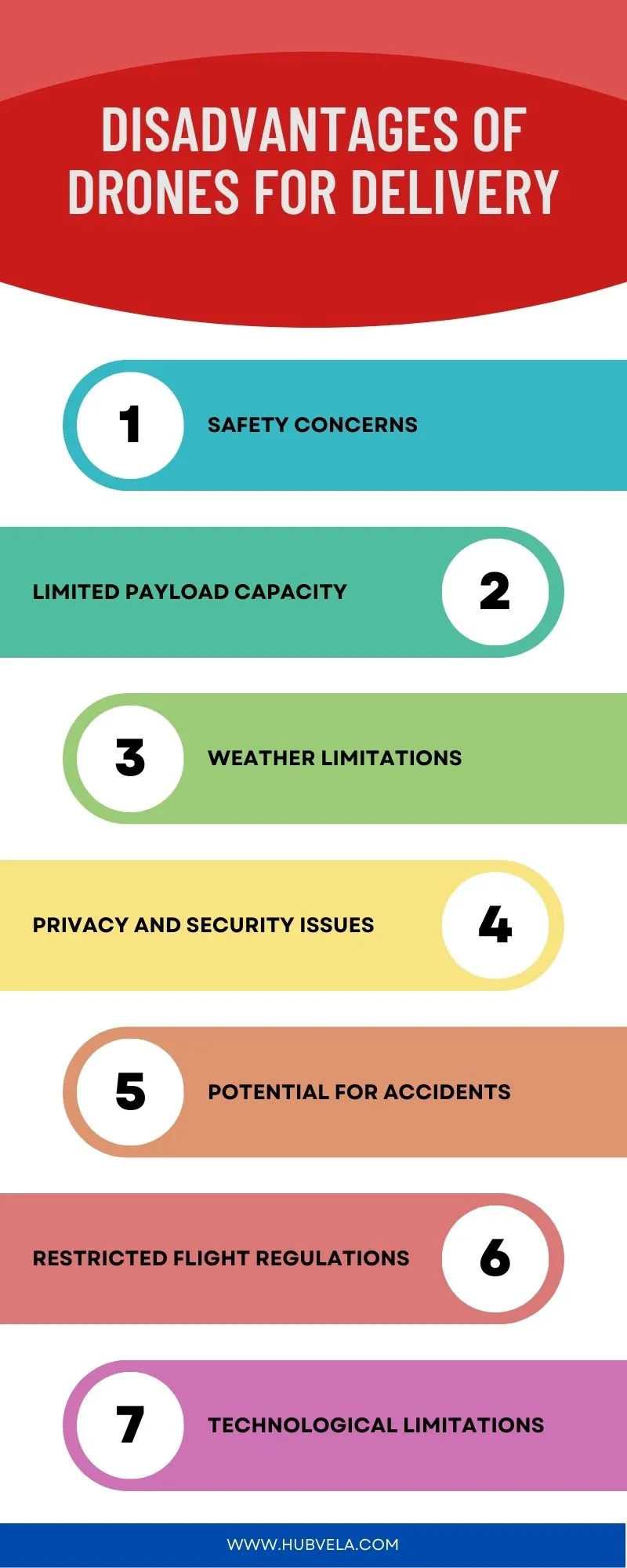In today’s rapidly evolving world of logistics, there exists a groundbreaking method of delivery that has sparked both intrigue and skepticism: drones.
These unmanned aerial vehicles offer a multitude of advantages, ranging from increased speed and convenience to cost-efficiency and accessibility.
However, as with any innovation, there are also certain drawbacks that warrant careful consideration. From potential accidents to restricted flight regulations and technological limitations, the use of drones for delivery is not without its challenges.
In this article we will explore the advantages and disadvantages of drones for delivery.

--Advertisement--
Advantages of Drones for Delivery
Drones are revolutionizing the delivery industry, offering numerous benefits that can enhance customer satisfaction, reduce costs, and promote sustainability. Some of the key advantages of drone delivery include:

1. Speed
Drones for delivery offer a significant advantage in terms of speed. Their efficiency and ability to navigate through traffic-free routes enable them to deliver packages quickly. With drones, delivery times can be significantly reduced, giving companies a competitive edge in the market.
Drones also provide an aerial view, allowing them to bypass obstacles and reach their destination faster. This speed not only improves delivery times but also enhances public perception of the company’s commitment to timely and efficient service.
2. Convenience
With drones for delivery, you can enjoy the convenience of having your packages brought directly to your doorstep in a timely manner. Drone regulations are constantly evolving, allowing for increased usage and improved customer satisfaction.
Delivery time is significantly reduced as drones can avoid traffic congestion in urban areas. As future development continues, drones will become an even more convenient option for delivering packages, making the process quick and hassle-free.
3. Cost-Efficiency
As you consider the convenience of having your packages delivered directly to your doorstep, it’s also worth exploring the cost-efficiency advantages of utilizing drones for delivery.
Drones offer significant cost savings by reducing labor and fuel expenses associated with traditional delivery methods. Additionally, their operational efficiency allows for faster delivery times, especially for last mile delivery.
Drones also have the potential for scalability, meaning they can handle a large volume of deliveries, making them a cost-effective option for businesses.
4. Accessibility
When it comes to accessibility, utilizing drones for delivery offers a range of advantages that can revolutionize the way packages are transported.
Drones can overcome regulatory challenges by operating in airspace where traditional delivery methods face restrictions.
They can reach remote areas that are difficult to access by road or other means.
With their ability to fly directly to the destination, drones can significantly reduce delivery times, especially for last mile delivery.
These accessibility benefits make drones a promising solution for efficient and timely package delivery.
5. Reduced Traffic Congestion
Utilizing drones for delivery offers advantages in terms of accessibility. It can also bring about a significant reduction in traffic congestion. By opting for drone delivery, reduced emissions from traditional delivery vehicles can be achieved, leading to cleaner air and a healthier environment.
Drones also contribute to increased efficiency and improved delivery times. This ensures that packages reach customers faster. This enhanced customer experience, coupled with reduced road infrastructure strain, makes drone delivery a promising solution for reducing traffic congestion.
6. Environmental Benefits
Drones for delivery offer numerous environmental benefits, making them a sustainable and efficient alternative to traditional delivery methods. With reduced emissions and noise pollution, drones have a significantly smaller carbon footprint compared to conventional vehicles.
They’re particularly beneficial for last mile delivery, as they can navigate through congested urban areas more easily. Drones also enable delivery to remote areas that may be inaccessible by road.
Moreover, their scalability allows for increased efficiency and reduced energy consumption.
7. Innovation
With their innovative capabilities, drones for delivery revolutionize the way packages are transported, offering a range of advantages that enhance efficiency and convenience. However, their adoption comes with certain challenges.
Regulatory challenges arise as authorities work to establish guidelines for safe and responsible drone operations. Public perception also plays a role, as some may have concerns about privacy and safety. Ethical considerations come into play when discussing the use of drones for delivery.
Additionally, the potential job displacement and infrastructure requirements must be considered when implementing drone delivery systems.
Disadvantages of Drones for Delivery
Drone delivery offers various benefits, such as speed, efficiency, and cost savings. However, it also has several disadvantages. Some of the drawbacks of drone delivery include:

1. Safety Concerns
One of the major concerns regarding the use of drones for delivery revolves around the potential safety risks they pose. Safety concerns arise from regulatory challenges, public perception, operational risks, and collision avoidance.
The integration of drones into the airspace raises questions about how to ensure their safe operation alongside other aircraft. Additionally, there’s a need to address public concerns about privacy, noise, and the potential for accidents. Proper safety measures and regulations must be in place to address these concerns.
2. Limited Payload Capacity
Drones for delivery have a significant disadvantage in terms of their limited payload capacity. This limitation affects delivery efficiency as drones can only carry a certain amount of weight. Additionally, the operational range of drones may be compromised due to the extra weight they’re carrying.
Along with limited payload capacity, battery life is also impacted, reducing the amount of time drones can stay in the air. Regulatory restrictions on maximum payload capacity further hinder the effectiveness of delivery drones.
3. Weather Limitations
With regards to the limitations of delivery drones, another significant drawback lies in their vulnerability to adverse weather conditions.
Weather conditions such as strong winds, rain, or snow can severely impact the performance of drones, affecting their delivery range and battery life.
Moreover, airspace restrictions during bad weather can further limit the ability of drones to navigate safely.
These challenges pose significant obstacles to the reliable and efficient use of drones for delivery purposes.
4. Privacy and Security Issues
Privacy and security concerns present significant challenges in the use of drones for delivery purposes. With the increasing use of drones, privacy concerns have emerged as a major issue. People worry about their personal information being collected and used without their consent. Data security is also a concern, as unauthorized access to sensitive information can lead to identity theft or other malicious activities.
Surveillance issues are another aspect, with the potential for drones to invade people’s privacy by recording or monitoring their activities. Stricter privacy regulations are needed to address these concerns.
5. Potential for Accidents
Delivery drones pose a significant risk of accidents during their operations.
The potential risks associated with drone delivery include:
– Mid-air collisions
– Crashes due to technical malfunctions
– Damage to property or injury to people on the ground.
These accidents could have serious insurance implications, as insurance coverage for drone operations isn’t yet well-established.
Moreover, public perception of drone deliveries may be negatively affected by accidents, leading to legal challenges and operational challenges for companies involved in this emerging industry.
6. Restricted Flight Regulations
As you consider the disadvantages of drones for delivery, it’s important to address the impact of restricted flight regulations on this emerging industry. Flight duration is affected by regulations that limit the maximum time a drone can stay in the air.
Airspace restrictions pose challenges for drone delivery companies, as they need to navigate through restricted zones.
Regulatory challenges also arise from the need to comply with various rules and regulations.
Additionally, public acceptance and privacy concerns further complicate the implementation of drone delivery services.
7. Technological Limitations
One major disadvantage of using drones for delivery is the limited payload capacity they can carry. While there have been significant technological advancements in drone technology, the operational challenges still remain.
Battery life and range limitations are two major factors that restrict the delivery capabilities of drones. Additionally, airspace restrictions imposed by regulatory bodies further hinder the efficiency of drone delivery systems.
These technological limitations must be addressed in order to fully maximize the potential of drones for delivery.
Conclusion on Advantages and Disadvantages of Drones for Delivery
In weighing the pros and cons of drones for delivery, it becomes evident that their potential benefits and drawbacks must be carefully considered.
While the advantages include increased efficiency and cost-effectiveness, there are concerns about the impact on jobs and public acceptance.
Additionally, the future potential of drone delivery is promising, but regulatory challenges need to be addressed.


